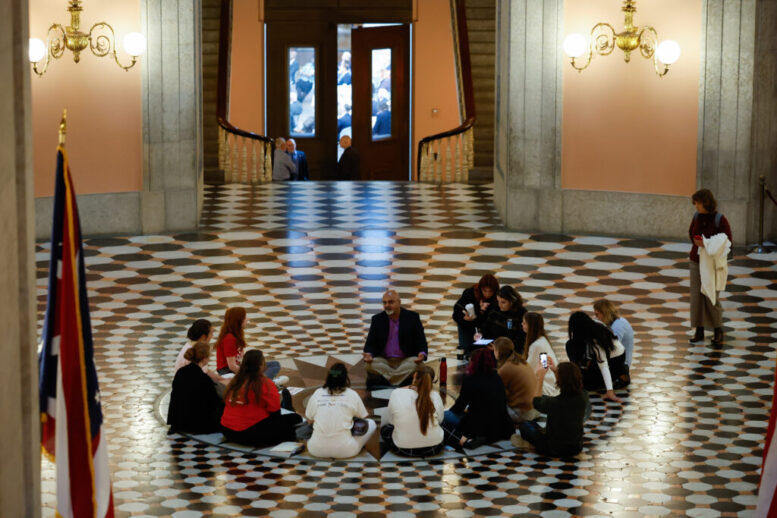BY MEGAN HENRY
The Republican lawmaker behind a wide-ranging, controversial higher education bill overhaul in Ohio says he’s making changes to his proposed piece of legislation.
State Sen. Jerry Cirino, R-Kirtland, has been working with House Higher Education Committee Chair Tom Young, R-Washington Twp., since the summer to make alterations to Senate Bill 83.

The bill, in it’s current version, would ban university staff and employees from striking, require college students to take certain American history courses, professor tenure would be based around “bias,” and mandatory diversity, equity and inclusion training would be prohibited, with only specific exemptions.
“I can’t publicly disclose (the changes) yet, but I think we’re down to the final two topics that need to be reconciled,” Cirino said Monday. He didn’t elaborate on what those two topics are.
The changes to the bill will be presented as a substitute bill for the House Higher Education Committee to vote on, he said. The committee does not meet this week.
If SB 83 passes the committee, it could potentially go to the floor of the House, which has its next meeting Nov. 15.
“It would be wonderful if they would be able to take it on the floor at that meeting,” Cirino said.
Senate Bill 83
SB 83 would reduce Board of Trustees terms from nine years down to six and require Ohio universities interested in starting new programs with China to get approval from the Chancellor of Higher Education and the Attorney General.
The bill passed 21-10 in the Senate (BGIN ed. note: State Sen. Theresa Gavarone, R-Bowling Green, voted in favor of the bill) but hasn’t gone before the House Higher Education Committee since the legislators resumed after summer break. It was originally scheduled on the House Higher Education Committee’s agenda for earlier this month only to be taken off days later.
SB 83 has received an outpouring of opposition since Cirino introduced the bill back in March and more than 500 people submitted opponent testimony to SB 83 during a marathon Senate Workforce and Higher Education meeting in April.
Symposium
While Cirino hosted a public university trustee governance symposium to discuss the future of higher education Monday at the Statehouse, about a dozen college students held a meeting of their own to talk about SB 83.
The Ohio Student Association, a statewide grassroots organization, organized a teach-in to discuss the history and implications of SB 83 — which included students from Ohio State University and the University of Cincinnati.
“We are here to make our voices heard and basically give the student perspective to raise our concerns regarding this bill,” said Tori Haller, an Ohio State University student.
SB 83 is “authoritarian,” said Pranav Jani, the president of Ohio State University’s chapter of American Association of University Professors.
“It is creating problems where they don’t exist,” he said. “It pretends to be for defending diversity of thought and balance in education, but it’s quite clearly from a conservative and I would say right-wing point of view.”
Chloe Freeman, a student at the University of Cincinnati, woke up at 6:30 a.m. to make it to the Statehouse in time for the teach-in.
“It’s very much just a bill about silencing the voices of students and free thought and free speech on campus,” she said. “It takes a lot of power away from the students and the professors.”
If SB 83 passed, lifelong Ohioans Freeman and Haller both said it would cause them to seriously question if they want to stay in Ohio.
“It is a conversation that I would have to have and something I would absolutely have to think about if this bill were to pass, but I don’t want to leave,” Haller said.
Also from Ohio Capital Journal:
New faces and familiar arguments in City Club of Cleveland’s Ohio Issue 1 forum
At the City Club of Cleveland last week, proponents and opponents debated Issue 1, which goes before Ohio voters this November. The proposal establishes a constitutional right for Ohioans to make their own reproductive healthcare decisions, including abortion. Both sides of the debate brought along an outside expert to bolster their arguments on stage.
The opponents continued to hammer on a series of questionable arguments. They warned darkly of parental rights evaporating and late term abortions becoming the norm. They ignored Ohio’s six-week abortion ban — on the books but tied up in courts — to argue Ohio’s current standard protects abortion through 22 weeks.
Issue 1 supporters pushed back on those claims, calling out “scare tactics” and insisting the proposal’s constitutional standards are nothing new. Just as they could after the landmark court decisions Roe and Casey, lawmakers will be able to regulate — or ban — abortion after fetal viability. But, just as those cases established, those limitations must include exceptions for protecting the life and health of the mother. READ MORE

